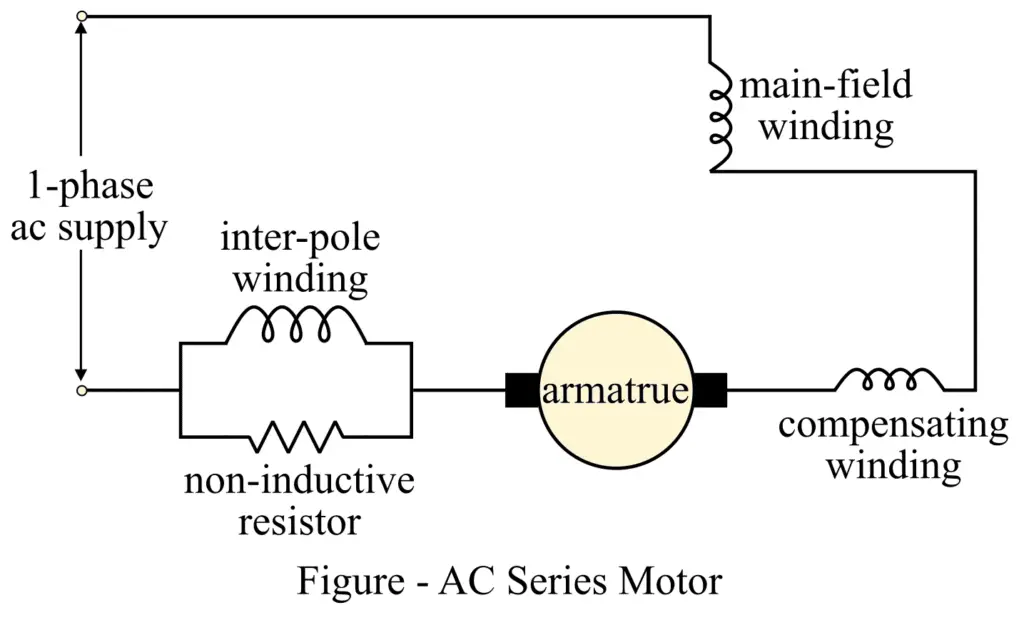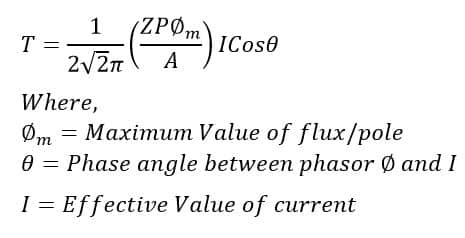In this article, we will discuss about AC traction motor or AC series motor used in AC electric traction applications.
Nowadays, vehicles like cars, scooters, trains, etc. are being electrified due to the increasing cost of petrochemical fuels and their limited availability. In electric tractions or electric vehicles, electric motors, either AC motors or DC motors, are used for supplying the driving power to the wheels of the vehicle. Modern electric traction systems made use of AC motors to obtain driving power. There are several types of AC motors available for traction purposes but the AC series motor is the best-suited motor for traction due to its high starting torque.
What is an AC Series Motor?
A series motor that can operate on a single-phase AC supply is termed an AC series motor. It is called a series motor because it has a stator and rotor winding connected in series and supplied from the same AC supply. It is a commutator-type ac motor.
However, an AC series motor may be operated on both single-phase AC supply and DC supply. AC series motors are also known as the modified DC series motor The construction of the AC series motor is very similar to that of the DC series motor. Therefore, the AC series motor is also called a modified DC series motor.
In practice, a DC series motor may also be operated by a single-phase AC supply. But it will not work satisfactorily due to the following reasons:
- When ac power is supplied to a dc series motor, a unidirectional torque is produced in the motor. But it has a frequency double the supply frequency.
- A DC series motor powered by an ac supply gives poor performance due to the inductive effect and low power factor of the series field winding.
- The AC supply causes sparking at the carbon brushes of the DC series motor.
- The AC supply produces eddy currents in the yoke and field cores that cause excessive heat generation.
Circuit Diagram of an AC Series Motor
The circuit diagram of a typical AC series motor is shown in the following figure.

From the circuit, we can notice that some modifications are made in the AC series motor when compared to DC series motor for satisfactory operation. These modifications are as follows:
- The field winding of an AC series motor must have a few turns so that it offers minimum inductive reactance.
- The number of turns in the armature winding must be increased in the same proportion as the number of turns reduced in the field winding. It is required to maintain the load torque constant. Because if we decrease the number of turns in the field winding, the MMF and hence flux will decrease. This increases the speed of the motor, and thus the load torque will decrease.
- The magnetic circuit core of the AC series motor should be made of thin laminations to reduce the eddy current loss.
- A compensating winding must be provided to balance the increased inductive reactance of the armature winding due to increased armature winding turns.
- AC series motor must be operated at a low voltage high current AC supply to produce the desired flux in the machine.
- To prevent the effect of inductive reactance of the field winding, the AC series motor must be operated at a low-frequency supply.
Average Torque of AC Series Motor
The average shaft torque value available on the motor shaft is given by,

From the above mathematical expression, it is clear that the torque of the AC series motor depends on the power factor. The AC series motor’s power factor at the starting time is low; hence, the motor delivers lesser torque than the DC series motor.
Salient Features of AC Series Motor
The following are the important characteristics of an AC series motor:
- The AC series motor has a very high start-up speed due to high starting torque.
- The weight of an AC series motor is about 1.5 to 2 times that of a DC series motor.
- For AC series motors, the operating voltage is limited to 300 V.
- AC series motors can be designed to the size of several 100 kW for traction applications.
- For AC series motors, the speed of the motor is inversely proportional to the armature current.
- The torque of the AC series motor is proportional to the square of the armature current.
Reversal of Rotation of AC series Motor
The direction of rotation of the AC series motor can be reversed by either changing the connection of the field or armature. The process of reversal of AC series motor direction is similar to that of DC series motor speed reversal. The interpoles and series connected compensating winding are treated as parts of the armature.
Applications of AC series Motor
The AC series motors produce high starting torque. Therefore, they are widely used in traction. Hoist and other applications where high starting torque is required.
Disadvantages of AC series Motor
The followings are the disadvantages of the AC series motors.
- The eddy current induced in the solid part like yoke and pole cores produced by alternating flux cause motor overheating, and, thus it lowers the efficiency of the motor.
- The large reactance of field winding lowers the power factor of the motor.
- During commutation, the voltage induced in the short-circuited armature cause sparking at brushes.
Conclusion
The AC series motors are best suited for electric traction motors over DC series motors due to their improved characteristics. However, the AC series motors are not suitable for suburban services with frequent stops due to their very low power at the time of starting operation. Thus, the AC series motors are most common in mainline services where high acceleration is needed and frequent stops are very less.